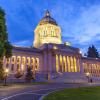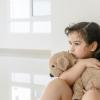
If yours is one of the many families flocking to the outdoors for a breath of fresh air, you’re bound to notice color. No, I’m not talking about the green fir trees or the golden mushrooms lurking under the soft brown loam. Most of the people you’re likely to pass on your hikes are white, as are the models in advertisements for outdoor gear and the park rangers tasked with making sure we recreate responsibly.
Data from the U.S. Forest Service and the National Park Service highlight how people of color are currently underrepresented in the outdoors. Black people made up around 13 percent of the population in the 2010 census, but only 1 percent of the visitors to our national parks. Like most inequities in our society, this lack of diversity stems from the impacts of systemic racism, including generational knowledge and experience, access and affordability, and historical trauma experienced in outdoor spaces.
Chelsea Murphy, a Washington-based activist and mother of two, wants to change the narrative about diversity in the outdoors. Her Instagram account (@she_colorsnature) documents her lived experience as a Black woman thriving in nature. She also shares her own anti-racism journey (including advocating for Indigenous populations) and how she fosters a positive nature-based childhood for her daughters.
Murphy and filmmaker Erin Joy Nash are presently collaborating on the Brave Space Film Project to feature the stories of Black, Indigenous and women of color who are redefining the term “outdoorsy.” We spent a few minutes catching up with Murphy to learn more about her work.
What inspired you to start She Colors Nature and how have your goals for your platform developed over time?
I grew up in more of a city setting, and playing outdoors looked different for me growing up. We engaged in hiking and camping and being outdoors as a family, but it didn’t look like the Western European traditional style of getting outdoors.
Living in the mountains, I saw a pattern of a lack of diversity on trails in Washington state. On a 2019 road trip to Idaho with my husband, I decided I wanted to start something and network with other mothers, specifically Black mothers, who are getting outdoors with their kids … so they can feel validated, resonate with my story and share theirs.
With the uprising over the summer of 2020 that we are all kind of reeling from, my platform did change a bit from simple verbiage to very intentional [language] about how we’re seeing a lack of diversity because there’s a fear of being outdoors connected with our country’s history for some Black folks. We also see a lack of access where the Black and Brown communities are in the city and proximity to nature is further out, and gear and education are extremely expensive.
What are some ways you’ve found to build a diverse and supportive community?
Right now, I’m working on a film project called the Brave Space Film Project. We put out a call for characters through the Instagram platform: “Attention: All Black, Indigenous and Women of Color [BIWOC] who love to get into the outdoors. We need voices and stories to tell.”
I didn’t realize that so many people would drive all over to adventure and be together as a community. Even just this past weekend we went snowshoeing together; it was such a fun time not having to hold back or to explain certain terms or verbiage, and just to be on the same wavelength to exist in nature as women with brown skin.
This time last year, I had a fundraiser where a local studio led a yoga class for moms and kids to raise money for the Wenatchi tribe in Washington state. I invited Mary from Wenatchi Wear, an apparel company that is trying to create awareness around the Wenatchi people. She said a couple of words about how they’re still here and how people can support the tribe. It was a night of creating awareness and intentional conversation, but also fun and goofy.
I’ve also led in my community by putting on a “mom trash crew,” where we pick a trail with our kids and hike and have intentional conversations while picking up trash.
I’m excited for the future to open up again and to feed the community I’ve started. It’s really important to see tweens and teens find connection to the outdoors. That was the age when I was the furthest away from my own love for nature. Girls are so fun and weird at that age — it would be cool to take mentorship on the trail and connect with that age group.
How has motherhood affected your experience of the outdoors?
Getting into nature was a huge part of my postpartum journey. When [moving] to the mountains to raise our kiddos, I knew no one in the town I live in. It was just a quiet time, and I often felt very alone.
I had a friend who took me out hiking and encouraged me to hike with my kids. I started doing that, and it blossomed into my relationship with nature and motherhood. I would hike with my kids and find peace and quiet by myself when my husband had the girls.
I am a firm believer that mothers should get out more with their kiddos if they can. There are barriers, and I understand it’s a privilege not everyone can afford, but that’s why I’m here — to close the gap of who’s getting out there.
For families that are new to getting outside, how would you recommend they start?
Be okay with being a beginner and not knowing it all and making mistakes.
Come as you are. You don’t have to have the biggest and brightest gear. You just need a pair of sneakers, your water bottle and a map. Use your resources, like the AllTrails app or Washington Trails [Association website], to understand how far you have to drive and the distance and elevation.
Choose trails that are appropriate for your skill level. Don’t go out the first time and choose a 14-miler. Choose trails that are in [cell phone] service range or where there are other people, so if something happens, you can ask for help or phone in case of emergency.
Shop secondhand. That’s how I’ve acquired all of my beginner hiking gear. Go the cheap route at first and find things at your local thrift store or Goodwill, break them in and be confident.
What are some ways you see white people gatekeeping outdoor recreation, and what are some actions you would like them to take to be more welcoming and inclusive?
Racism is a structural problem. [Some people think] the outdoors is one place we shouldn’t talk about racism, but I beg to differ. There’s a major problem, and we can’t run from it at this point.
It starts with brands, community leaders, and boards for organizations and nonprofits. If they’re not doing the work internally, then the people who are supporting them financially won’t hold them to a higher standard.
A lot of it is tearing down the idea of who is “outdoorsy.” It can include foraging for elderberries because your ancestors have always done that, or an herbalist collecting things that help them feel healthy year-round. Maybe you’re in the Latinx community and you bring your whole family out on the trail. There shouldn’t be a right or wrong way of engaging, because nature isn’t ours to begin with.
The [Brave Space] film has opened my eyes to how so many people engage with nature. In a community that’s diverse, all ways of connecting with nature are welcomed. In regards to social and racial justice, I believe it’s important to use the strategy of calling people in, rather than calling them out. I don’t want to encourage a culture around shame or guilt, but if those are things you are feeling when looking at anti-racism suggestions, I encourage you to lean into that feeling and acknowledge what that might be. Racial awareness needs to be looked at on a structural and individual level, understanding how our country’s systems affect our individual actions. Go forth with the mentality of “when you know better, you do better.”
You and filmmaker Erin Joy Nash recently started the Brave Space Film Project, which is made by and features women of color passionate about experiencing the outdoors. What was the casting process like and can you give us an idea of what to expect?
After I put out that call to action, COVID really constricted our casting. We weren’t able to travel and had to limit ourselves to Washington state, but we realized that’s a blessing in disguise. We’ve created this community with people we can actually hang out with.
[Out of 55 responses,] we narrowed it down to 12 characters in Washington, myself included, who are from the area, but we didn’t weed anybody out. We have an array of women doing an array of things, from playing ukulele on Coast Salish land to summiting Vesper Peak and everything in between. We’ve titled the film “Expedition Reclamation,” and it’s currently scheduled to debut in summer of 2021.
For so long there haven’t been a lot of women filmmakers and barely any BIPOC women filmmakers. I think this film is going to be one of the first of its kind in relation to how it’s being produced — it’s very community-based. Our team is multicultural and we coproduce, codirect ... co-everything!
What’s next for Brave Space Media and how can folks support you?
We’re launching our crowdfunding campaign on March 9. You can also sign up for film updates on our website. We’ll need an army of people who are ready to build up this community, to share what we’re doing in this brave space, and to encourage other women, especially BIPOC women. We’re also communicating with brands and nonprofit organizations to land on a fiscal sponsor so we can begin accepting sponsors and grants.
We have lots of hope for this film — this project is so amazing that it deserves to be shown on a big screen with hundreds of people watching. We want BIPOC people to come see the film and to hold storytelling events and community-building moments or retreats for private or public showings. We are hoping that white folks who see this will begin to understand the importance of all voices, to get behind our narrative of re-creating what it looks like to be “outdoorsy,” and to have an open mind and heart. If that means waiting due to COVID, then we’re not in a hurry to release the film. We’re hoping things start to get better over the spring and summer. Here’s to dreaming!











